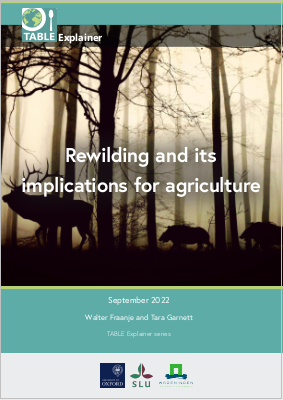See the full report on Table Debates website here
What is rewilding?
Rewilding is a concept that has gained increasing prominence in recent years in discussions about nature conservation and the future of agricultural landscapes. Encompassing a range of strategies, rewilding - in its most general sense - refers to the idea of giving land back to nature as a means of restoring (global) biodiversity and strengthening ecosystems to become more resilient and autonomous. The concept, however, has a longer history and carries more specific meanings for different groups who support or oppose (different versions of) rewilding. Understanding this history and the different rewilding perspectives helps shed light on the controversies around the concept. Developed by a group of North American conservation biologists in the 1990s, rewilding in its original conception was defined by three principles, known as the 3C model:
• Cores: creating large areas (>100,000 hectares) without human intervention;
• Corridors: establishing linkages between them;
• Carnivores: Introducing large carnivores (e.g., wolves) as keystone species (i.e., a species which have a disproportionately large effect on the ecosystem in which it occurs) that can lead biodiversity to self restore.
The ultimate aim of the 3C approach is to restore ecosystems to a diversity and complexity that is similar to that of the Pleistocene era (roughly 2.5 million to 11,700 years ago, before the advent of agriculture). This version of rewilding originates from a concern with and critique of nature conservation, which early rewilders argued has been preoccupied with protecting the species that are currently still present in a given ecosystem while failing to tackle the underlying causes of persistent biodiversity loss. Rewilding sought to be more ambitious in its vision for ecosystems by restoring them to a distant past. Underpinning the 3C approach is the idea that the reintroduction of (relatives of) extinct carnivore species, combined with the protection of large swathes of land from human interference, will enable ecosystems to become more complex and biodiverse.
Today, rewilding is a heterogeneous and evolving movement which includes an increasingly diverse range of context-specific strategies beyond the original 3C model. Generally, two primary, yet somewhat overlapping, schools of thought have emerged about how to implement rewilding efforts: trophic rewilding and passive rewilding. Trophic rewilding focuses on restoring the complex web of predator-prey interactions in an ecosystem, building on the original 3C approach but without explicitly naming a specific historical baseline or ideal scale rewilding should be applied at. It generally revolves around the intentional reintroduction of large herbivore or carnivore species by humans. In contrast, passive rewilding denotes the spontaneous rewilding of ecosystems when land is left to its own devices. Passive rewilding involves little or no human intervention and does not specify an ideal historical baseline or seek to actively reintroduce keystone species. To date, most rewilding projects have, by and large, followed the trophic rewilding approach. Relatively few in number and implemented at a fairly small scale, rewilding projects are currently primarily found in North America and Europe, but also more recently spread to other parts of the world including South Africa and China. Besides these rewilding projects, there are also significant amounts of land globally - likely much more than currently covered by rewilding projects - that are rewilding passively simply because agricultural land has been abandoned.


